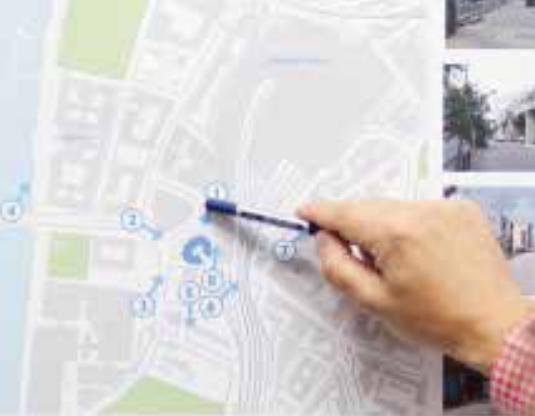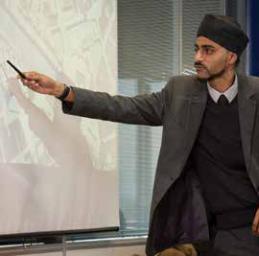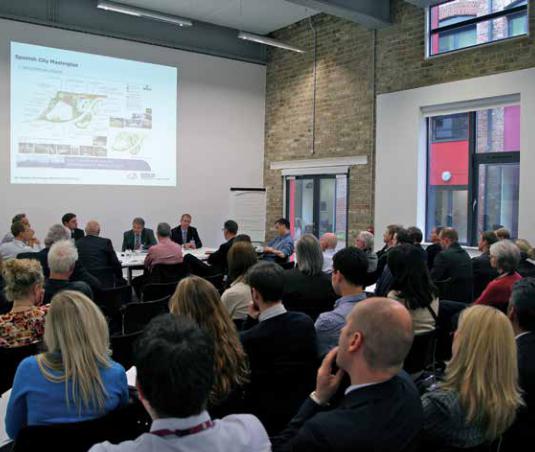
attachment_8
.pdf
Proportionate
Establishing criteria for scheme selection
Each panel should set criteria for the size and type of schemes it reviews that match the scope and level of service that it can offer.
However, it may sometimes be appropriate to move outside these criteria for schemes that are particularly significant or unique.
These might include
• situations where the local planning authorityisconfrontingadifficultdecision in which design is a central issue.
• a scheme that, even though not of great significance in itself, typifies design issues that recur frequently.
• a scheme that sets a standard for a larger area of redevelopment.
It can also be worth reviewing good schemes with no major design flaws to add support to a project that might be controversial locally.
Panels work most effectively when they are reviewing specific design and building proposals, rather than strategies. Urban design frameworks, planning policy documents and strategies are increasingly being considered as subjects for review but they need a different approach, usually involving a specialist panel of expert design and planning professionals. The process is based on Design Review but adapted to reflect the different process of assessing a text document concerned with planning.
Timely
Review at an early stage of design development
Design Review should be a conversation about work in progress, not a verdict on an outcome.
The pre-application stage of the planning process, while the design is still fluid, is the best time for a review. It will help the scheme’s proposers to identify aspects of design that should be improved and support the planning authority in resolving design issues before the application is submitted. Planning applicants want a favourable decision quickly, and the better the quality of the proposal the less delay there is likely to be. If the applicant has discussed the project with the local planning authority
and arranged an independent assessment through the design review process, the decision-making process is likely to be faster. The review may occasionally take place before the pre-application meeting with the planners, but it is more likely to follow it, once the wider policy matters have been aired.
In the formal planning application process, a positive design review report can underpin approval for a well-designed proposal. The report can also provide critical analysis required for attaching conditions to an approval, or turning down a low-quality proposal.
Leaving Design Review until the planning application stage will almost certainly make it more difficult for the design team to make any suggested changes, and harder for the planning authority to meet the proposer’s preferred schedule.
© Ben Blossom
Delivering the principles 19

Advisory
A critical friend
Apanel’sjobistoofferimpartialadvice, nottodecide,designorinstruct.Itcan encourage clients to act on its advice by reporting positively on the good aspects of a scheme as well as being objectively criticalofitsperceivedflaws.Itisalso
perfectly legitimate for the panel to question the client’s original brief. For example, if thepanelthinksthebriefhasspecifiedtoo much accommodation on a site, it should say so. Fundamental criticism is sometimes
necessary, even though it may be unwelcome to the people who have committed time, effortandmoneytoaproject.
Some panels prefer to have part of their discussions in private to avoid confrontation or offence, but this is not recommended. There is considerable benefit in allowing everyone involved to hear the whole discussion. Listening to the reasons for the panel’s views will help people understand them so panel members must have the confidence to voice their criticism in front of the scheme’s presenters.
Objective
Avoiding prejudices of style, taste or fashion
The design review panel offers objective advice based on professional judgement and an understanding of the principles of good design. Each project is considered in the round, in light of the impact it will have on its surroundings. This is interpreted as widely as possible. The effect it will have on the surrounding landscape and its distinctive historic and cultural context, has to be evaluated, but so do the implications for
the areas circulation patterns, neighbouring activities, and property uses. The views and sensitivities of the surrounding community should also be given weight. Aesthetic considerations are naturally relevant, but panel members should avoid straying into areas of personal preference unless they are supported by reasoned argument.
20 Delivering the principles

© Ben Blossom
Accessible |
• It should be objective and robust enough |
|
to be defended confidently if the scheme |
||
Clear advice |
is the subject of an appeal. |
|
• It should never attribute comments to |
||
The design advice that the panel provides |
||
is only as valuable as the written report that |
individual members of the panel. |
|
conveys it. The report should turn the panel’s |
It should be clear in the first paragraph of the |
|
deliberations into a coherent summary, with |
||
advice that can be acted on. |
report whether the panel thinks: |
|
• The report should be clear and succinct, |
• this is a good project that they support |
|
as it stands, |
||
written in plain English without acronyms |
||
and jargon. |
• this is a project that they could support |
|
• It should explain the purpose of the |
provided improvements are made, or |
|
panel’s advice, who the advice is for and |
• a fundamental re-think is required. |
|
what action they are expected to take. |
The chair has a critical role in assuring the |
|
• It should summarise the main issues and |
||
the panel’s conclusions. |
quality of the written report by summing up, |
|
• It should identify the strengths and |
clearly and precisely, the advice that emerges |
|
from the review and then scrutinising, |
||
weaknesses the panel has found in the |
amending and approving the draft. The |
|
brief, the aims and objectives of the |
reportisthedefinitiverecordofthepanel’s |
|
client, or the design proposal. |
conclusions and should be an accurate |
|
• It should demonstrate a proper grasp |
reflectionoftheviewsgivenatthemeeting. |
|
Once it is written, it supersedes any remarks |
||
of design issues and avoid straying into |
||
made by individual members at the meeting. |
||
prescriptive detail. |
||
|
||
• It should be frank but constructive. |
It is essential that the report should be issued |
|
|
promptly, in accord with the schedules |
|
|
stated in advance. |
Delivering the principles 21

Chapter 6
A robust Design Review process
Preparation
Resources
Thenumberofstaffandthefacilitiesthepanel needs will depend on the number of projects theyexpecttoreview.Mostlocalpanelshave twomembersofstaff,anadministratorand a panel manager. Cabe’s Design Review team consists of the Head of Design Review supported by case advisors who deliver reviewsandofficerswhomanagethedelivery process. Some local panels are managed
bylocalauthoritystafffromtheplanningor urbandesignteam.Itmaybeusefultolook atotherpanels’websitestofindoutwhat arrangements they have in place concerning time,costsandcontractualmatters.Itshould also be possible contact them directly to ask for their advice.
Designreviewstaffneedathorough understanding of both the design development process and the planning system. Their duties include:
•identifying projects for review.
•liaising with the scheme promoters or applicants.
•forming an understanding of the scheme throughbriefings,drawingsandsitevisits.
•briefing the panel.
•managing the panel meeting process.
•writing up the panel’s comments and advice, and carrying out any follow-up work required.
Itisessentialthatdesignreviewstaffhave qualificationsandpracticalexperience inthesefields.Theyshouldalsohavethe
communication skills required to liaise with scheme promoters, planners, panel members and other design review panels.
Arranging panel meetings
The dates for design review meetings should be planned well in advance to ensure that members with the right mix of professional skills will be able to attend, even if one or two have to stand down because ofconflictsofinterest.Otherexpertbodies with specialist interests such as heritage or the natural environment should be invited where appropriate.
Agenda papers should be sent out a week in advance to help members prepare for the meeting. The papers should include enough background information about the projects scheduled for review to allow members to declareanyconflictsofinterest.However, scheme designs should not be circulated before the meeting. Experience suggests that if panel members come to the meeting with their minds already made up about the quality of the scheme it will compromise the objectivityofthereview.Inanycase,design
teams may well be working on their project up to the last minute before the review meeting.
Choosing the type of review
Mostreviewsarecarriedoutaspresentation sessions, where the design team and client present the scheme to the panel. This has manyadvantages.Itgivesthedesignteam the opportunity to make a personal case for their ideas, engage in discussion and hear the panel’s comments directly.
An alternative format, desktop review, involves a much smaller meeting between the chair, a second panel member and panelstaff.Thisisanefficientwaytoassess returning schemes and those at the planning application stage.
When deciding which approach to use, a balance needs to be struck between the need for a fast response and the desirability of having each scheme being presented by its promoters.
22 A robust Design Review process

Venues and facilities
Meetings may be held in one regular venue or in a different places depending on convenience and availability. Using a single venue allows the panel to make the arrangements for the presentation without having to start from scratch each time. However, a venue close to the location of the scheme might be chosen to tie in with a site visit.
There are several factors to consider when choosing a venue. It should be fully accessible, with enough room for everyone to sit and circulate comfortably. Boards to display drawings and space for models
will be required. Audio-visual equipment may be needed for three dimensional fly-throughs or other on-screen presentations. Visitors who want to conceal confidential plans or models should be asked to bring their own black-out materials.
Itshouldbestressedtothoseattendingthat drawings and three-dimensional models are the main form of presentation required by the panel. Other media should be treated as secondary, and if a team wants to display images on screen they should also provide printouts at A3 size for later study.
Briefingschemepromoters
Design review panels usually allow the scheme’s promoters and design team to be present at the panel discussion. For this to work well, they should be briefed on how to present their proposals clearly and succinctly. A standard guidance document or webpage is the best way to do this.
The guidance information should
• outline the review process and present a typical agenda with indicative timings.
• suggest how the promoter can use the time available to present the scheme fully but succinctly using diagrams, architectural drawings, visualisations, words and audio visual media.
• explain who the panel’s advice will be aimed at, how soon after the review it will be issued, and what action will then be expected.
Designreviewstaffshouldbeavailableto offeranyfurtheradviceaboutpanelmeetings and presentations that the promoters or design team may ask for.
Site visits
Wherever possible, each development site should be visited by all the panel members before the review meeting. At the local level this can usually be arranged, but sometimes it may simply not be possible. Nevertheless, it is very important that panel members are fully aware of the characteristics of the site, context and key issues. These details may be communicated to panel members, where necessary,throughbriefingpapers,aerialand other photos of the site and its surroundings, andabriefingbypanelstaffwhohavevisited the site.
Masterplans
Where masterplans are being discussed, the panel may have to adapt their usual procedurestoreflectthescaleoftheissues involved.Therewillbespecificquestionsto be addressed at a masterplan review, and moretimewillusuallybeneeded.Members
should be carefully selected to ensure that the panel includes professionals with experience of development on a larger scale and its particular complexities.
A robust Design Review process 23
Review
Structuring the meeting
Panel meetings will run more smoothly if they follow a clear structure. The following suggestions and timings will be a useful starting point. Straightforward projects can be reviewed in up to 90 minutes, although larger and more complex projects will take longer.Somelocalpanelsmayfitsixor seven small schemes into a half day session, and while this limits the time for discussion it may be appropriate where matters are straightforward.
1.Closedbriefingforpanelmembers
Staffshouldbriefpanelmembersinprivate beforeareview,introducingthesignificant aspects of the site and its planning history, and identifying any key issues known about the proposal. The design and client team, local authority representatives and other observers are invited into the room after this closedbriefing.
2. Welcome
At the start of the sessions the chair will greet the presenters, local authority representativeandanyobservers.If observers are present, the chair should ensure they understand they are not part of the panel and should conduct themselves accordingly. They should not try to contribute unless invited to do so by the chair.
3. Presentation
The client can be asked to introduce the presentation with a two or three minute overview of the brief, aims and objectives of the scheme. The architect or designer could then be invited to talk through the main design issues. Fifteen to 30 minutes,
depending on the complexity of the scheme, is usually enough time for the presentation.
4. The local authority view
At some point during the review, the chair might invite the local authority to outline their views of the project and talk about the policy context. This can either be done
immediately after the presentation or as part of the general discussion.
5. Comment and discussion
The chair should invite panel members to make their initial observations and ask for any clarifications or further information they need. Presenters should be allowed to respond to criticisms, but they must not be allowed to dominate the meeting. The chair should structure the discussion so that it flows from the general, such as the project’s overall strategy, to the more detailed aspects of the design.
Chairs and panel members should remember thatthefirstreviewofaschemeisthemost important.Itisthestageatwhichanymajor issues should be raised. Subsequent revisions will be reviewed in the light of the comments made at the previous review meeting.
Panel members must make sure that any fundamental opinions or reservations they have about the project are made clear before the client and project team leave the room.
Itisimportantthatthepanel’sviewsare expressed openly to the presenting team.
Iftherearemajordifferencesofopinion between panel members, they should discuss them and reach a resolution. The chair must ensure that the presenting team go away with an accurate understanding of the panel’s views.
Only where the panel remains clearly divided will it be necessary to reach a consensus in private, and this should be a rare occurrence.
6. Concluding in private
Once the chair has summarised the discussion, the presenting team should be thanked and asked to leave. The chair andpanelcanthenconfirmtheirviews inprivate,andthestaffmembercan
summarise the points that will be covered in thewrittenreport.Itisinappropriatefornew observations to be introduced during this closed discussion.
24 A robust Design Review process

Observers
Attendance at design review meetings can be a valuable source of Continuing
Professional Development for panel members andfacilitators.Aslongasconfidentialityis notcompromised,itcanalsoofferaunique learning opportunity for other practitioners by allowing them to listen to experts discussing design.Beingpresentatareviewmeeting willhelplocalplanningofficersandcouncil members to develop their skills, and provide them with new ideas on how to assess good design. People who are not directly engaged inthespecificDesignReviewbutwhomay have related or parallel responsibilities should be encouraged to attend a review meeting from time to time.
Cabeoffersawiderangeofpeople,from government ministers to interested school students, opportunities to attend their design reviewmeetings.Aswellasbenefittingthe observers themselves, this is a useful way of demonstratingtheeffectivenessofDesign
Review as widely as possible, and making the panel more inclusive without compromising the principles of objectivity.
Design review panels may occasionally hold a design review meeting in public. As long as agreement is obtained from the promoters and the local authority, this can be an appropriate way to involve the community in the planning system.
Ifobserversaretobepresentthechairshould ensure that the presenting team know this before the meeting, and all observers must bemadeawareoftheconfidentialityrequired, particularly with pre-application schemes.
Meeting the Nolan principles
Design review panels are set up to act in the public interest. All members and chairs must therefore abide by the seven Nolan Principles ofPublicLife—selflessness,integrity, objectivity, accountability, openness, honesty and leadership.
© John Beattie
A robust Design Review process 25

Advice
Advice and follow-up
The formal Design Review advice report is not a minute of the panel discussion, but it should be based on comprehensive notes taken at the meeting by the panel manager or case adviser charged with writing the report. At pre-application stage the advice should be addressed to the client/design team and copied to the local planning authority for theirinformation.Iftheschemeisaplanning application the advice should be addressed to the local planning authority and copied to the client/design team for their information. The advice should make clear whether
thepanelsupportstheproposalorfinds fundamentalflawsinthedesignthatprovides a robust case for refusal in line with paragraph 64 of the NPPF10. The report should contain appropriate praise as well as criticism,
and point out the strengths of a proposal alongsideanyflaws.
A formal report should include the names of the chair and panel members, either in themaintextorasafootnote.Ifareportis later found to contain an error and has to be withdrawn, the date on the corrected report
should be the same as on the original but the document must be clearly marked with a note explaining the reason for its reissue.
Following up after review
Itisimportanttobeabletooffersome feedback or further reviews, particularly if the scheme is one that the panel could not support. A meeting to explain the panel’s advice report should not be required, but the panelstafforchairshouldbepreparedto
offerclarificationifitissought.Incaseswhere radical design changes have been suggested, the panel will want to see that design quality has been improved and maintained through thedevelopmentprocess,andoffersome consistency of advice. This can usually be achievedbyofferingtoreviewthescheme again after the revisions have been carried out
Ifaschemecomesinforafollow-upreview, thepanelmustbewellbriefedbythestaff toavoidcontradictingthefirstreview’s comments. Wherever possible, some of the samepanelmembersfromthefirstreview meeting should attend follow-up reviews. When a scheme is submitted as a planning application, a second review should take place so that the planning authority has a formal response from the panel to the designs submitted in the planning application.
10.NPPF para 64 ‘Permission should be refused for development of poor design that fails to take the opportunities available for improving character and quality of a area and the way it functions.’
26 A robust Design Review process

Other practical matters
The business plan and preparatory work
All review panels should draw up a business plan and programme of work. This is important for any type of panel, no matter how it is set up. Experienced panels can advise on this. As part of their preparation, managers of new panels should attend meetings of other panels and familiarise themselves with all parts of the design review process, including site visits and preparatory meetings. Managers of existing panels in the area could meet to discuss the issues and ensure that best practice is shared.
Promoting the panel
Whatever level the panel is working at, the design review service will need to be promoted widely targeting the people and organisations who might use it, such as local associations of developers, project managers, architects and landscape architects. Panels must make it clear who can submit a scheme to them for review. The best approach is to state openly
and transparently that submissions from throughout the public and the private sectors are welcomed.
Itisimportanttoestablishandmaintain a dialogue with the planning authority at the highest level. This could be achieved by regular meetings with heads of planning and councillors.
Perhaps the most direct way of promoting and publicising Design Review is to publish brochures and set up a website containing all the information needed by project promoters. In addition to a contact name and address, it should provide profiles of panel members, criteria for selecting schemes for review and application forms.
The manager, panels chair and members of the advisory board or steering group should be available to publicise the panel, and active in seeking out suitable projects for review and answering enquiries from scheme promoters and the public.
Kentish Town Health Centre © Tim Soar / Allford Hall Monaghan Morris
A robust Design Review process 27

Useful contacts
Cabe team at the Design Council |
Landscape Institute |
Angel Building |
Charles Darwin House |
407 St John Street |
12 Roger Street |
London EC1V 4AB |
London WC1N 2JU |
Tel: 020 7420 5200 |
Tel: 020 7685 2640 |
www.designcouncil.org.uk |
www.landscapeinstitute.org |
Royal Institute of British Architects |
The Royal Town Planning Institute |
66 Portland Place |
41 Botolph Lane |
London W1B 1AD |
London EC3R 8DL |
Tel: 020 7580 5533 |
Tel: 020 7929 9494 |
www.architecture.com |
www.rtpi.org.uk |
Design Network
East Midlands |
North West |
West Midlands |
OPUN/Architecture East Midlands |
Places Matter! |
MADE |
Phoenix House |
RIBA |
7 Newhall Square |
Nottingham Road |
Unit 101, The Tea Factory |
Birmingham B3 1RU |
Melton Mowbray |
82 Wood Street |
www.made.org.uk |
Leicestershire LE13 0UL |
Liverpool L1 4DQ |
Tel: 0121 348 7980 |
www.opun.org.uk |
www.placesmatter.co.uk |
|
Tel: 07967 638 786 |
Tel: 0151 703 0135 |
Yorkshire & Humber |
East of England |
South East |
Integreat Plus |
71-75 Columbia Place, |
||
Shape East |
South East Regional Design Panel |
Leadmill Road, |
13 - 15 Covent Garden |
Kent Architecture Centre |
Sheffield. S2 4AR |
Cambridge |
Admiral’s Offices |
www.integreatplus.com |
CB1 2HS |
Main Gate Road |
Tel: 0114 213 0040 |
www.shape-east.org.uk |
Historic Dockyard |
|
Tel: 01223 462 606 |
Chatham |
|
North East |
Kent ME4 4TZ |
|
www.architecturecentre.org |
|
|
North East Design Review & Enabling |
Tel: 01634 401166 |
|
Service |
South West |
|
RIBA |
|
|
Northumbria University |
Creating Excellence |
|
Ellison Building |
Dennett House |
|
Ellison Place |
11 Middle Street |
|
Newcastle NE1 8ST |
Taunton |
|
www.ne-dres.co.uk |
TA1 1SH |
|
Tel: 0191 2617441 |
www.creatingexcellence.org.uk |
|
|
Tel: 01823 250823 |
|
28 Useful contacts
